Josiah Wedgwood
Josiah Wedgwood (12 July 1730 – 3 January 1795) was an English potter and entrepreneur. He founded the Wedgwood company. He was the leader in the industrialisation of the manufacture of pottery. "It was by intensifying the division of labour that Wedgwood brought about the reduction of cost which enabled his pottery to find markets in all parts of Britain, and also of Europe and America."[1] The renewed classical enthusiasms of the late 1760s and early 1770s were of major importance to his sales promotion.[2] His expensive goods were in much demand from the upper classes, while he used emulation effects to market cheaper sets to the rest of society.[3] Every new invention that Wedgwood produced – green glaze, creamware, black basalt and jasper – was quickly copied.[4] Having once achieved efficiency in production, he obtained efficiencies in sales and distribution.[5] His showrooms in London gave the public the chance to see his complete range of tableware.[6]
Josiah Wedgwood | |
|---|---|
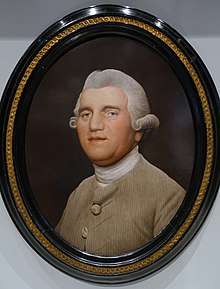 Josiah Wedgwood by George Stubbs, 1780, enamel on a Wedgwood ceramic tablet | |
| Born | 12 July 1730 |
| Died | 3 January 1795 (aged 64) Etruria, Staffordshire, England |
| Resting place | Stoke-on-Trent, England |
| Occupation | Potter, entrepreneur |

Meeting the demands of the consumer revolution and growth in wealth of the middle classes that helped drive the Industrial Revolution in Britain, Wedgwood is credited as the inventor of modern marketing.[7] He pioneered direct mail, money back guarantees, travelling salesmen, carrying patterned boxes for display, self-service, free delivery, buy one get one free, and illustrated catalogues.[8]
A prominent abolitionist fighting slavery, Wedgwood is remembered too for his "Am I Not a Man And a Brother?" anti-slavery medallion. He was a member of the Darwin–Wedgwood family, and he was the grandfather of Charles and Emma Darwin.
Biography
Early life
Born in Burslem, Staffordshire, the eleventh and last child of potter Thomas Wedgwood (d. 1739) and Mary Wedgwood (née Stringer; d. 1766), Josiah was raised within a family of English Dissenters, he was the grandson of a Unitarian minister and was an active Unitarian. By the age of nine, he was proving himself to be a skilled potter. He survived a childhood bout of smallpox to serve as an apprentice potter under his eldest brother Thomas Wedgwood IV.[9] Smallpox left Josiah with a permanently weakened knee, which made him unable to work the foot pedal of a potter's wheel. As a result, he concentrated from an early age on designing pottery and then making it with the input of other potters. The pottery created in his father's and brother's business was inexpensive and low quality, black and mottled in color.[9]
In his early twenties, Wedgwood began working with the most renowned English pottery-maker of his day, Thomas Whieldon, who eventually became his business partner in 1754. Wedgwood also began to study the new science of chemistry, seeking to understand the materials science of fire, clay, and minerals and to develop better clays and glazes for potter-making. Following an accident in 1762, Wedgwood met Joseph Priestley, another Dissenter and a chemist who gave Wedgwood advice on chemistry.[9] Wedgwood's experimentation with a wide variety of techniques coincided with the burgeoning of the nearby industrial city of Manchester. Inspired, Wedgwood leased the Ivy Works in the town of Burslem. From 1768 to 1780 he partnered with Thomas Bentley, a businessman from a landowning family who was socially sophisticated and had astute taste.[10] Over the course of the next decade, his experimentation (and a considerable injection of capital from his marriage to a richly endowed distant cousin) transformed the sleepy artisan works into the first true pottery factory.
Marriage and children
In January 1764 Wedgwood married Sarah Wedgwood (1734–1815), his third cousin. They had eight children:
- Susannah Wedgwood (3 January 1765 – 1817) married Robert Darwin and became the mother of the English naturalist Charles Darwin. Charles married Emma Wedgwood, his cousin. The doubled family inheritance of Wedgwood wealth created by his grandfather gave Charles Darwin the leisure time to formulate his theory of evolution.
- John Wedgwood (1766–1844), joined the business rather reluctantly, mainly interested in horticulture
- Richard Wedgwood (1767–1768) (died as a child)
- Josiah Wedgwood II (1769–1843) (father of Emma Darwin, cousin and wife of Charles Darwin)
- Thomas Wedgwood (1771–1805) (no children), best known as a pioneer photographer
- Catherine Wedgwood (1774–1823) (no children)
- Sarah Wedgwood (1776–1856) (no children, very active in the abolition movement)[11]
- Mary Anne Wedgwood (1778–86) (died as a child)
Work
Wedgwood was keenly interested in the scientific advances of his day and it was this interest that underpinned his adoption of its approach and methods to revolutionize the quality of his pottery. His unique glazes began to distinguish his wares from anything else on the market.
By 1763, he was receiving orders from the highest levels of the British nobility, including Queen Charlotte. Wedgwood convinced her to let him name the line of pottery she had purchased "Queen's Ware", and trumpeted the royal association in his paperwork and stationery. Anything Wedgwood made for the Queen was automatically exhibited before it was delivered.[12] In 1764, he received his first order from abroad. Wedgwood marketed his Queen's Ware at affordable prices, everywhere in the world British trading ships sailed. In 1767 he wrote, "The demand for this sd. Creamcolour, Alias, Queen Ware, Alias, Ivory, still increases -- It is amazing how rapidly the use of it has spread all most [sic] over the whole Globe."[13]
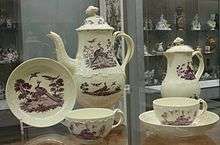
He first opened a warehouse at Charles Street, Mayfair in London as early as 1765 and it soon became an integral part of his sales organization. In two years, his trade had outgrown his rooms in Grosvenor Square.[14] In 1767, Wedgwood and Bentley drew up an agreement to divide decorative wares between them, the domestic wares being sold on Wedgwood's behalf.[15] A special display room was built to beguile the fashionable company. Wedgwood's in fact had become one of the most fashionable meeting places in London. His workers had to work day and night to satisfy the demand, and the crowds of visitors showed no sign of abating.[16] The proliferating decoration, the exuberant colours, and the universal gilding of rococo were banished, the splendours of baroque became distasteful; the intricacies of chinoiserie lost their favour. The demand was for purity, simplicity and antiquity.[17] To encourage this outward spread of fashion and to speed it on its way Wedgwood set up warehouses and showrooms at Bath, Liverpool and Dublin in addition to his showrooms at Etruria and in Westminster.[18] Great care was taken in timing the openings, and new goods were held back to increase their effect.[12]
The most important of Wedgwood's early achievements in vase production was the perfection of the black stoneware body, which he called "basalt". This body could imitate the colour and shapes of Etruscan or Greek vases which were being excavated in Italy. In 1769, "vases was all the cry" in London; he opened a new factory called Etruria, north of Stoke. Wedgwood became what he wished to be: "Vase Maker General to the Universe".[19] Around 1771, he started to experiment with Jasperware, but he did not advertise this new product for a couple of years.
Sir George Strickland, 6th Baronet, was asked for advice on getting models from Rome.[20] Gilding was to prove unpopular, and around 1772, Wedgwood reduced the amount of "offensive gilding" in response to suggestions from Sir William Hamilton.[21] When English society found the uncompromisingly naked figure of the classics "too warm" for their taste, and the ardor of the Greek gods too readily apparent, Wedgwood was quick to cloak their pagan immodesty - gowns for the girls and fig leaves for the gods were usually sufficient.[22] Just as he felt that his flowerpots would sell more if they were called "duches of Devonshire flowerpots", his creamware more if called Queensware, so he longed for Brown, James Wyatt, and the brothers Adam to lead the architect in the use of his chimney pieces and for George Stubbs to lead the way in the use of Wedgwood plaques.
Wedgwood hoped to monopolize the aristocratic market and thus win for his wares a special social cachet which would filter to all classes of society. Wedgwood fully realised the value of such a lead and made the most of it by giving his pottery the name of its patron: Queensware, Royal Pattern, Russian pattern, Bedford, Oxford and Chetwynd vases for instance. Whether they owned the original or merely possessed a Wedgwood copy mattered little to Wedgwood's customers.[23] In 1773 they published the first Ornamental Catalogue, an illustrated catalogue of shapes.[15] A plaque, in Wedgwood's blue pottery style, marking the site of his London showrooms between 1774 and 1795 in Wedgwood Mews, is located at 12, Greek Street, London, W1.[24]
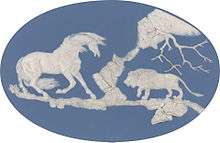
In 1773, Empress Catherine the Great ordered the (Green) Frog Service from Wedgwood, consisting of 952 pieces and over a thousand original paintings, for the Kekerekeksinen Palace (palace on a frog swamp (in Finnish)), later known as Chesme Palace. Most of the painting was carried out in Wedgwood's decorating studio at Chelsea.[25] Its display, Wedgwood thought, 'would bring an immence (sic) number of People of Fashion into our Rooms. For over a month the fashionable world thronged the rooms and blocked the streets with their carriages.[26] (Catharine paid £2,700. It can still be seen in the Hermitage Museum.[27]) Strictly uneconomical in themselves, the advertising value of these productions were huge.[28]
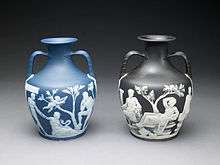
As a leading industrialist, Wedgwood was a major backer of the Trent and Mersey Canal dug between the River Trent and River Mersey, during which time he became friends with Erasmus Darwin. Later that decade, his burgeoning business caused him to move from the smaller Ivy Works to the newly built Etruria Works, which would run for 180 years. The factory was named after the Etruria district of Italy, where black porcelain dating to Etruscan times was being excavated. Wedgwood found this porcelain inspiring, and his first major commercial success was its duplication with what he called "Black Basalt". He combined experiments in his art and in the technique of mass production with an interest in improved roads, canals, schools and living conditions. At Etruria, he even built a village for his workers.
Not long after the new works opened, continuing trouble with his smallpox-afflicted knee made necessary the amputation of his right leg. In 1780, his long-time business partner Thomas Bentley died, and Wedgwood turned to Darwin for help in running the business. As a result of the close association that grew up between the Wedgwood and Darwin families, Josiah's eldest daughter would later marry Erasmus' son.
To clinch his position as leader of the new fashion, he sought out the famous Barberini vase as the final test of his technical skill.[17] Wedgwood's obsession was to duplicate the Portland Vase, a blue-and-white glass vase dating to the first century BC. He worked on the project for three years, eventually producing what he considered a satisfactory copy in 1789.
In 1784, Wedgwood was exporting nearly 80% of his total produce. By 1790, he had sold his wares in every city in Europe.[29] To give his customers a greater feeling of the rarity of his goods, he strictly limited the number of jaspers on display in his rooms at any given time.
After passing on his company to his sons, Wedgwood died at home, probably of cancer of the jaw, in 1795. He was buried three days later in the parish church of Stoke-on-Trent.[30] Seven years later a marble memorial tablet commissioned by his sons was installed there.[31]
Legacy and influence
— Sir Howard Stringer, chairman of Sony Corporation, 2012.[32]
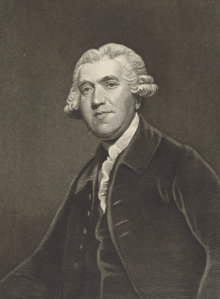
One of the wealthiest entrepreneurs of the 18th century, Wedgwood created goods to meet the demands of the consumer revolution and growth in wealth of the middle classes that helped drive the Industrial Revolution in Britain.[7] He is credited as the inventor of modern marketing, specifically direct mail, money back guarantees, travelling salesmen, carrying pattern boxes for display, self-service, free delivery, buy one get one free, and illustrated catalogues.[8] Wedgwood is also noted as an early adopter/founder of managerial accounting principles in Anthony Hopwood's "Archaeology of Accounting Systems."
He was a friend, and commercial rival, of the potter John Turner the elder; their works have sometimes been misattributed.[33][34] For the further comfort of his foreign buyers he employed French-, German-, Italian- and Dutch-speaking clerks and answered their letters in their native tongue.[35]
Wedgwood belonged to the fifth generation of a family of potters whose traditional occupation continued through another five generations. Wedgwood's company is still a famous name in pottery today (as part of Waterford Wedgwood; see Waterford Crystal), and "Wedgwood China" is sometimes used as a term for his Jasperware, the coloured stoneware with applied relief decoration (usually white), still common throughout the world.
Abolitionism
.jpg)
Wedgwood was a prominent slavery abolitionist. His friendship with Thomas Clarkson – abolitionist campaigner and the first historian of the British abolition movement – aroused his interest in slavery. Wedgwood mass-produced cameos depicting the seal for the Society for Effecting the Abolition of the Slave Trade and had them widely distributed, which thereby became a popular and celebrated image. The Wedgwood medallion was the most famous image of a black person in all of 18th-century art.[36] The actual design of the cameo was probably done by either William Hackwood or Henry Webber who were modellers in his Stoke-on-Trent factory.[37]
From 1787 until his death in 1795, Josiah Wedgwood actively participated in the abolition-of-slavery cause. His Slave Medallion brought public attention to abolition.[38] Wedgwood reproduced the design in a cameo with the black figure against a white background and donated hundreds to the society for distribution. Thomas Clarkson wrote; "ladies wore them in bracelets, and others had them fitted up in an ornamental manner as pins for their hair. At length the taste for wearing them became general, and thus fashion, which usually confines itself to worthless things, was seen for once in the honorable office of promoting the cause of justice, humanity and freedom".[39]
The design on the medallion became popular and was used elsewhere: large-scale copies were painted to hang on walls[40] and it was used on clay tobacco pipes.[41]
Inventions
He was elected to the Royal Society in 1783 for the development of a pyrometer, a device to measure the extremely high temperatures that are found in kilns during the firing of pottery.[42]
He was an active member of the Lunar Society of Birmingham often held at Erasmus Darwin House and is remembered on the Moonstones in Birmingham.
See also
- Erasmus Darwin House, Erasmus Darwin Museum house and gardens
- A locomotive named "Josiah Wedgwood" ran on the Cheddleton Railway Centre in 1977. It returned in May 2016 following ten years away.[43]
- Commemorating the landing of the First Fleet at Sydney Cove in January 1788, Wedgwood made the Sydney Cove Medallion, using a sample of clay from the cove from Sir Joseph Banks, who had himself received it from Governor Arthur Phillip. Wedgwood made the commemorative medallion with the motto "Hope encouraging Art and Labour, under the influence of Peace, to pursue the employments necessary to give security and happiness to an infant settlement".[44]
Notes
- Ashton, T. S. (1948). The Industrial Revolution 1760–1830, p. 81
- McKendrick 1982, p. 113
- McKendrick 1982, p. 105.
- McKendrick 1982, p. 107.
- McKendrick 1982, p. 108.
- Rendell, Mike (2015). "The Georgians in 100 Facts". p. 40. Amberley Publishing Limited
- "Why the Industrial Revolution Happened Here". BBC. 11 January 2017.
- "They Broke It". New York Times. 9 January 2009.
- Meyer, Michal (2018). "Old Friends". Distillations. Science History Institute. 4 (1): 6–9. Retrieved 26 June 2018.
- Thomson, Gary (November 1995). "Josiah Wedgwood. (cover story)". Antiques & Collecting Magazine.
- Midgley, Clare (1992). Women Against Slavery. New York: Routledge. p. 56. ISBN 0-203-64531-6.
- McKendrick 1982, p. 121.
- Thomson, Gary (November 1995). "Josiah Wedgwood. (cover story)". Antiques & Collecting Magazine.
- McKendrick 1982, p. 118.
- Coutts, Howard. The Art of Ceramics. European Ceramic Design 1500-1830, p. 180.
- McKendrick 1982, p. 119.
- McKendrick 1982, p. 114.
- McKendrick 1982, p. 120.
- McKendrick 1982, p. 140.
- McKendrick 1982, p. 110-111.
- The Art of Ceramics. European Ceramic Design 1500-1830, Howard Coutts, p. 181.
- McKendrick 1982, p. 113.
- McKendrick 1982, p. 112.
- "Plaque: Josiah Wedgwood". londonremembers.com. 2013. Retrieved 18 October 2013.
- The Art of Ceramics. European Ceramic Design 1500-1830 by Howard Coutts, p. 185.
- McKendrick 1982, p. 122.
- Pieces from the Green Frog Service. Josiah Wedgwood (1773–1774) Archived 22 March 2009 at the Wayback Machine, Hermitage Museum
- McKendrick 1982, p. 110.
- McKendrick 1982, pp. 134-135.
- "History & Heritage". stokeminster.org/. Archived from the original on 19 October 2013. Retrieved 18 October 2013.
- "Creative sector seeks to create wider support". BBC. 14 January 2017.
- "John Turner". thepotteries.org. Retrieved 2 June 2016.
- "New Hall Works, Shelton". thepotteries.org. Retrieved 2 June 2016.
- McKendrick 1982, p. 134.
- "British History – Abolition of the Slave Trade 1807". BBC. Retrieved 11 April 2009.
The Wedgwood medallion was the most famous image of a black person in all of 18th-century art.
- "Am I Not a Man and a Brother?", 1787
- Did you know? – Josiah WEDGWOOD was a keen advocate of the slavery abolition movement. Thepotteries.org. Retrieved on 2011-01-02.
- "Wedgwood". Archived from the original on 8 July 2009. Retrieved 13 July 2009.
Thomas Clarkson wrote; ladies wore them in bracelets, and others had them fitted up in an ornamental manner as pins for their hair. At length the taste for wearing them became general, and thus fashion, which usually confines itself to worthless things, was seen for once in the honourable office of promoting the cause of justice, humanity and freedom.
- Scotland and the Slave Trade: 2007 Bicentenary of the Abolition of the Slave Trade Act, The Scottish Government, 23 March 2007
- A History of the World – Object : anti-slavery tobacco pipe. BBC. Retrieved on 2011-01-02.
- "BBC - History - Historic Figures: Josiah Wedgwood (1730 - 1795)". bbc.co.uk.
- "A brief history of the CVR php". hurnet-valley-railway.co.uk. Archived from the original on 10 July 2010. Retrieved 2 January 2011.
- "National Museum of Australia". nma.gov.au.
References
- Dolan, Brian (2004). Wedgwood: The First Tycoon. Viking Adult. ISBN 0-670-03346-4
- McKendrick, Neil. "Josiah Wedgwood and the Commercialization of the Potteries", in: McKendrick, Neil; Brewer, John & Plumb, J.H. (1982), The Birth of a Consumer Society: The commercialization of Eighteenth-century England
Further reading
- Burton, Anthony. Josiah Wedgwood: A New Biography (2020)
- Koehn, Nancy F. Brand New : How Entrepreneurs Earned Consumers' Trust from Wedgwood to Dell (2001) pp 11-42.
- Langton, John. "The ecological theory of bureaucracy: The case of Josiah Wedgwood and the British pottery industry." Administrative Science Quarterly (1984): 330-354.
- McKendrick, Neil. "Josiah Wedgwood and Factory Discipline." Historical Journal 4.1 (1961): 30-55. online
- McKendrick, Neil. "Josiah Wedgwood and cost accounting in the Industrial Revolution." Economic History Review 23.1 (1970): 45-67. online
- McKendrick, Neil. "Josiah Wedgwood: an eighteenth-century entrepreneur in salesmanship and marketing techniques." Economic History Review 12.3 (1960): 408-433. online
- Meteyard, Eliza. Life and Works of Wedgwood (2 vol 1865) vol 1 online; also vol 2 online
- Reilly, Robin, Josiah Wedgwood 1730-1795 (1992), scholarly biography
- Wedgwood, Julia, and Charles Harold Herford. The Personal Life of Josiah Wedgwood, the Potter (1915) online
External links
| Wikimedia Commons has media related to Josiah Wedgwood. |
| Wikisource has the text of the 1911 Encyclopædia Britannica article Wedgwood, Josiah. |
- Wedgwood website
- Vaizey, Marina, "Science into Art, Art into Science", The Tretyakov Gallery Magazine, No 2, 2016 (51) (good online summary)
- Wedgwood collection at the Lady Lever Art Gallery
- Wedgwood Museum
- The Great Crash by Jenny Uglow, The Guardian, 7 February 2009
- National Museum of Australia The Sydney Cove Medallion (Flash required for close-up viewing).
- The Story of Wedgwood
- Josiah Wedgwood Correspondence (transcripts), John Rylands Library, Manchester.